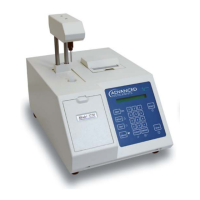9
Hazardous Material Cautions
• A discharge of static electricity from contact with the human body or other conductor
may damage system boards or static sensitive devices. Never perform internal
maintenance without following recommended static protection procedures.
• The product is equipped with operator accessible fuses. If a fuse blows, it may be due to
a power surge or failure of a component. Replace the fuse only once. If the fuse blows
a second time, it is probably caused by failure of a component part. If this occurs, refer
service to qualified service personnel. Always replace the fuse with one of the same
rating, voltage, and type. Never replace the fuse with one of a higher current rating.
• When servicing the product, use only factory-specified parts.
• WARNING: When returning this product for service, or shipping this product to a second
location, remove all hazardous specimens and decontaminate the product before
packaging for shipment. If the product cannot be decontaminated, consult with your
shipping agent on appropriate packaging and marking.
Hazardous Material Cautions
• WARNING: Handle all biohazardous materials according to established good laboratory
practices and follow your institution’s exposure control plan. Persons handling human
blood and body fluid samples must be trained in blood-borne hazards and observe
universal precautions. Universal precautions is an approach to infection control,
where all human blood and body fluids are treated as if known to be infectious. Use
personal protective equipment such as gloves, gowns, etc., to prevent exposure. Store
biohazardous materials in regulated waste containers and dispose of these materials
in a safe and acceptable manner that is in compliance with all country, state and local
requirements.
• If a biohazardous material is spilled on or inside the equipment, decontaminate the
equipment using a 1% bleach solution, or as outlined by those policies and procedures
established within your institution.
• To avoid injury or fire hazard, do not operate this product in an explosive atmosphere.
FCC Requirements
WARNING: Changes or modifications to this unit not expressly approved by Advanced
Instruments could void the user’s authority to operate the equipment.
• This equipment has been tested and found to comply with the limits for a Class B
digital device, pursuant to Part 15 of the FCC Rules. These limits are designed to provide
reasonable protection against harmful interference in a residential installation. This
equipment generates, uses, and can radiate radio frequency energy and, if not installed
and used in accordance with the instructions, may cause harmful interference to radio
communications. However, there is no guarantee that interference will not occur in a
particular installation. If this equipment does cause harmful interference to radio or
television reception, which can be determined by turning the equipment off and on, the
user is encouraged to try to correct the interference by one or more of the following
measures:
– Reorient or relocate the receiving antenna.
– Increase the separation between the equipment and receiver.
– Connect the equipment into an outlet on a circuit different from that to which the
receiver is connected.
– Consult the dealer or an experienced radio TV technician for help.

